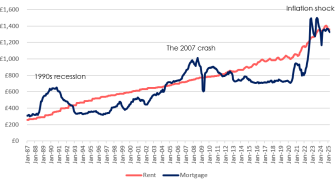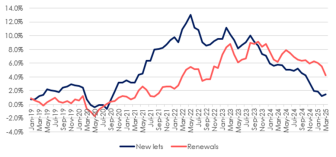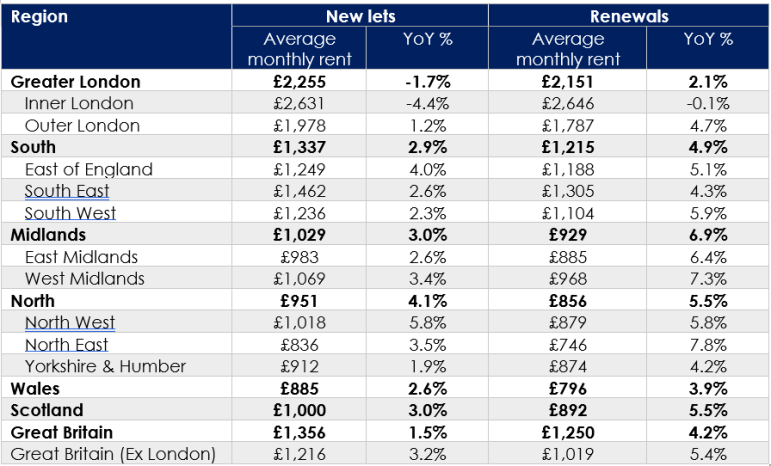 The difference between the monthly cost of renting and paying a mortgage for small deposit borrowers is now around the same, according to Hamptons.
The difference between the monthly cost of renting and paying a mortgage for small deposit borrowers is now around the same, according to Hamptons.
Today, typical mortgage rates of just over 5% for a first-time buyer with a 10% deposit mean the average monthly mortgage payment (£1,328) is slightly cheaper than the average rental payment (£1,356) (chart 1). This time two years ago, as interest rates rose, renting became £48 per month cheaper than buying.
For most of the last 40 years, it’s been cheaper to buy than rent. In just 36% of the months since January 1987 it has been cheaper to rent than buy (chart 1).
Since January 1987, there have only been three occasions when renting has been cheaper than buying for someone purchasing a home with a 10% deposit over a 30-year mortgage term (chart 1). During these three occasions, it was rising mortgage rates that pushed up the cost of buying rather than rents falling.
Firstly, in the early 1990s, mortgage rates hit 15%, pushing the average monthly mortgage payment for someone with a 10% deposit up to £649, nearly double the cost of renting at £358. As interest rates fell, the trend normalised and buying became cheaper throughout the rest of the 1990s and most of the 2000s.
Chart 1 – The monthly cost of renting vs paying a mortgage with a 10% deposit (Great Britain)
Source: Hamptons & BoE
It was not until around 2007 when banks raised rates on small deposit mortgages that the balance swung back in favour of renting again and remained that way until 2010. The third instance when renting became cheaper than buying occurred just after the ‘mini budget’ (back in 2022), when mortgage rates rose steeply.
While nationally, the monthly cost of renting remains similar to the cost of buying today, the figures mask a north-south divide. In all four southern regions, it remains cheaper to rent a home than buy it on a monthly basis (table 1).
Table 1 – The monthly cost of renting vs paying a mortgage with a 10% deposit
| Monthly rent | Monthly mortgage | Difference | |
| London | £2,255 | £2,370 | -£115 |
| Inner London | £2,631 | £2,725 | -£95 |
| Outer London | £1,978 | £2,101 | -£123 |
| South East | £1,462 | £1,497 | -£35 |
| South West | £1,236 | £1,243 | -£7 |
| East of England | £1,249 | £1,369 | -£120 |
| East Midlands | £983 | £1,009 | -£26 |
| West Midlands | £1,069 | £1,012 | £58 |
| Yorkshire & Humber | £912 | £858 | £54 |
| North East | £836 | £690 | £146 |
| North West | £1,018 | £892 | £126 |
| Wales | £885 | £880 | £5 |
| Scotland | £1,000 | £749 | £251 |
| GB | £1,356 | £1,328 | £29 |
Source: Hamptons & BoE
In all four regions of the south higher mortgage rates remain a bigger barrier to affordability. In London, renting has been cheaper than buying since July 2022, when mortgage rates stood at 3.69%. Today, the average Londoner could save £115 per month by renting (table 1).
While further north it typically remains cheaper to buy than rent on a monthly basis, even at much higher interest rates. In the North East, the monthly cost of renting hasn’t been higher than the cost of buying since July 2011.
This reflects how the same mortgage rate is felt differently across the country. Generally, the mortgage rate required to equalise the monthly cost of renting and buying tends to be lower across the south of the country than further north. While Londoners with a 10% deposit require rates of around 4.6% to equalise the cost of renting and buying, further north, it takes mortgage rates of above 6.0% to make buying as expensive as renting (table 2).
Table 2 – The mortgage rate required to equalise the cost of renting vs paying a mortgage with a 10% deposit
| London | 4.6% |
| Inner London | 4.8% |
| Outer London | 4.6% |
| South East | 4.9% |
| South West | 5.1% |
| East of England | 4.3% |
| East Midlands | 4.9% |
| West Midlands | 5.6% |
| Yorkshire & Humber | 5.7% |
| North East | 6.9% |
| North West | 6.3% |
| Wales | 5.2% |
| Scotland | 7.9% |
| GB | 5.1% |
Higher mortgage rates that push up the cost of buying relative to renting are a reflection of the extra amount buyers pay in interest. This is amplified when people buy more expensive homes, such as in the South of England.
At the typical mortgage rate currently available to a first-time buyer with a 10% deposit (5.11% spread over a 30-year term), it takes 16.5 years for the repayment to outweigh the interest element of their monthly mortgage payment.
However, when interest rates peaked at 6.57% in August 2023, it would have taken an average of 19.5 years for mortgage repayments to outweigh mortgage interest. This means that 86% of the first payment towards a mortgage taken out in August 2023 went to cover the interest being charged on the loan.
Back in March 2022 when average rates were just 2.38%, mortgage repayments would have outweighed mortgage interest after just one year, with interest accounting for just 49% of a first-time buyer’s initial mortgage payment. If mortgage rates remained the same for the whole 30-year term, a person paying the 2.38% rate would pay 69% less in interest (or £206,000 on the average loan) than the person paying the 6.57% rate.
Rental growth
In the 12 months to March 2025, the cost of a newly agreed tenancy in Great Britain rose by 1.5% to £1,356 pcm (chart 2, table 3). This marks the third consecutive month when annual rental growth has been running below 2% and the fifth consecutive month when rental growth across the nation has been below general inflation (CPI).
Meanwhile, the average cost of renewing a tenancy grew by 4.2% nationally in the 12 months to March, bringing the average cost to £1,250 pcm, £106 a month less than a tenant moving into a new home (chart 2, table 3). This means the rate of increase for renewed tenancies has been higher than that of new lets in every month since September 2023.
London continues to be a drag on rental growth, with rents down 1.7% on the same time last year. This puts the average cost of a newly let home in the capital at £2,255pcm (table 3), the lowest level in almost two years. Slowing rental growth in the capital has been driven by falls in Inner London, where prices fell by 4.4% year-on-year. Meanwhile, Outer London Rents grew by 1.2% (table 3).
Chart 2 – Change in newly agreed and renewal rents across Great Britain
Source: Hamptons
Table 3 – Rental growth in March 2025
Source: Hamptons
Aneisha Beveridge, head of research at Hamptons, said: “Since the 1980s, it’s typically taken an economic shock for renting to drop materially below the cost of buying. When this happens, it’s almost always driven by the cost of buying rising rapidly, pushed up by mortgage rates jumping for those with smaller deposits who are perceived to be riskier borrowers when prices may fall. But we are now seeing the impact of the inflation shock unwinding.
“Relative to the cost of paying a mortgage, rents tend to be much less volatile. Typically, they’re tightly tied to both wages and inflation. This means that while they rarely fall, they also tend to rise more slowly unless general inflation escapes its 2% target. When this happens, rents are often driven up by the higher costs faced by landlords, like we saw in 2022-2023, ranging from higher mortgage payments to bigger bills from tradesmen.
“Should central banks perceive an emerging trade war as a growing threat to economic growth, it could create room for faster rate cuts. This could translate into falling mortgage rates, potentially cutting the cost of both buying and potentially renting too. Given these costs form a large part of official inflation statistics, this would put material downward pressure on the headline inflation figure.”
Read the orginal article: https://propertyindustryeye.com/monthly-rent-now-just-29-more-than-a-small-deposit-mortgage-repayment-hamptons/





